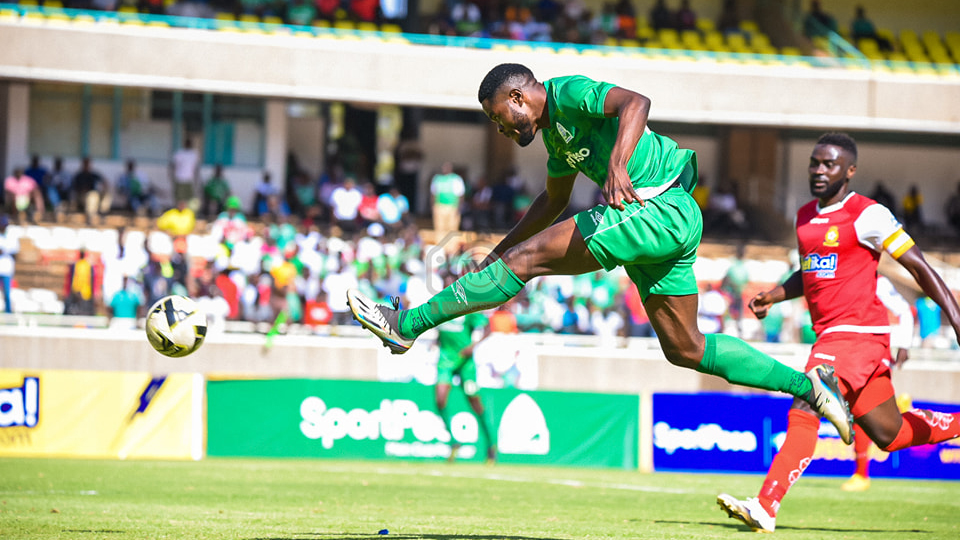Gor Mahia handed Kenya Police FC a significant setback in their pursuit of the Kenyan Premier League title after securing a 2-1 victory in a highly anticipated encounter on Saturday afternoon. Jonathan Mckinstry’s tactical nous was instrumental in securing the three points for Sirkal, as Gor Mahia like to be called.Gor Mahia’s solid defensive structure and tactical discipline have made it difficult for opposing teams to create consistent high-quality chances. Kenya Police FC, however, with their abundance of attacking quality, were keen to end Gor Mahia’s stubborn resistance.Both teams approached the game with the aim of gaining superiority in a qualitative, numerical, positional, and dynamic sense, through immaculate spacing, pinning, isolating, and overloading while in possession, and by ensuring minimal space between the lines of structure while out of possession. Heaven sent Omala strikes again to hand Gor sweet victory over Kenya PoliceIn this tactical analysis, we’ll take a closer look at how the two teams approached the game tactically. We’ll examine how Francis Baraza’s attacking structure and right-sided combinations came up short against Mckinstry’s mid-block, and the significance of Benson Omala’s contribution in the final third.Gor Mahia set up in a 4-2-4 structure, looking to build out from the back by splitting the center backs each side of goalkeeper Gad Mathews, with Ernest Wendo dropping deep to create a triangle with the two center backs. With Kenya Police FC pressing man-to-man, Gor Mahia’s right-back Paul Ochuoga positioned himself higher up the pitch to become the free man. Police FC’s Duke Abuya, in their pressing structure, looked to block the passing lane back to Dennis Njire Nganga while pressing Gor Mahia’s other center-back, Joshua Onyango, on the ball. Police FC structure Gor Mahia maintained a solid attacking structure with the left side more consistent in how the players were positioned. On the right side, players in close proximity combined well with each other, with John Macharia and Paul Ochuoga rotating between occupying the inside channels and hugging the touchline, while Austin Odhiambo dropped deep between the lines. Although Gor Mahia’s right side looked potent and confident, Police FC’s David Owino put up some excellent 1v1 defending early in the game to stifle most attacks.##NAJAVA_MECA_7049880##Gor Mahia caused Police problems with good combinations and wide rotations, with line-breaking passes inside the channels and Omala and Austin Odhiambo receiving the ball on the half-turn. Austin Odhiambo, Gor Mahia’s central attacking midfielder, found pockets of space between the second and last lines of pressure of Police. His movement created space for Omala in the channels to conjure up something. Gor Mahia build up phase with Police aggressive high press, leaving Ochuoga as the free manOmala’s deep-lying role in the game troubled the Police defensive partnership, as he dropped deep to link play and drag markers out to create space to be exploited out wide by the pace of Macharia and Omondi Boniface.Police shifted to a compact 4-4-1-1 mid-block with heavy emphasis on central compactness, making it tough for Gor Mahia to access Omala between the lines. However, the onus was on Police to chase a match-winning goal, which left space out wide in the channels that Gor Mahia capitalized on, culminating in Omala’s match-winning goal from a well-weighted ball from Mathews into the channel to set Boniface free. He sent his man to the cleaners, squared the ball to Omala, who finished with some hesitant goalkeeping from the Police goalkeeper.Gor Mahia made several changes, with Peter Lwasa and George Odhiambo being brought on. This left Omalla and Lwasa operating between the lines with Wendo and Alpha Onyango the double pivot to prevent transitions.Police FC looked to play in a very compact 4-4-2/4-4-1-1 In the buildup phase they looked to set out in a 3-4-3 by playing with Patilah Omotto dropping between the centre back to push the fullbacks higher up the field. This structure also saw Francis Kahata invert and drop deep to form a pivot with Lesley while, Miheso, Rupia and Abuya looked to pin back the backline. Police build-up phaseGor Mahia applied a rather disjointed press in a 4-4-2 with the main trigger being Police FC playing the ball out wide, this made Austin and Omala jumped. Police could find a free man centrally in areas vacated by Austin and Omala and look to dictate play from there.In the final third, Police FC midfielders looked to force Gor Mahia’s 4-4-2 midblock deeper so they could get more control of the ball and sustain more pressure but the aggression and bite of Wendo and Ochieng saw minimal progression. Duke Abuya became crucial as his movements were to create space inside the channels. He looked to combine well with the wingers and dragged markers away centrally to create space for Rupia. The Police goal was a brilliant example of their socio-effective superiority between players and combinations, after neat combinations on the right, Clifton Miheso did well to let in a cross, Abuya’s movement and good first touch out of pressure saw him attract markers to him and he duly lobbed the ball perfectly to an unmarked Rupia. This goal was vintage Police as Gor Head Coach McKinstry even noted, stating they had tried to work to contain it a lot in training. Gor Mahia in advanced possession Overall, Mckinstry’s side adapted well to the in game situations, as they sustained the tempo with very good aggression in duels while retaining greater threat in transition.

